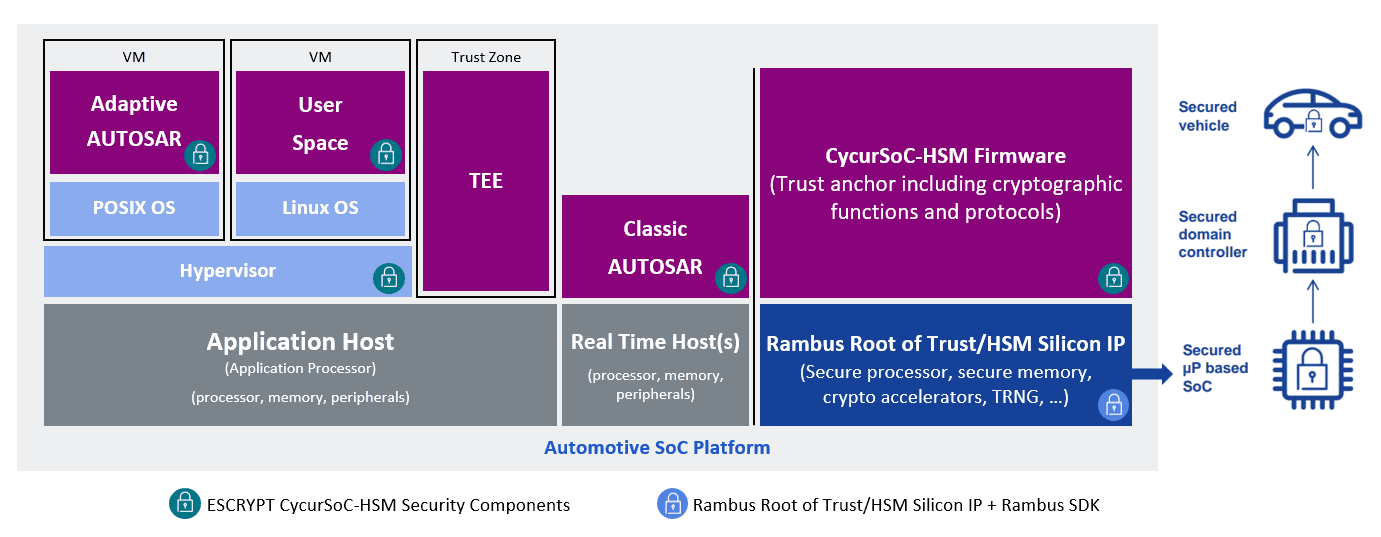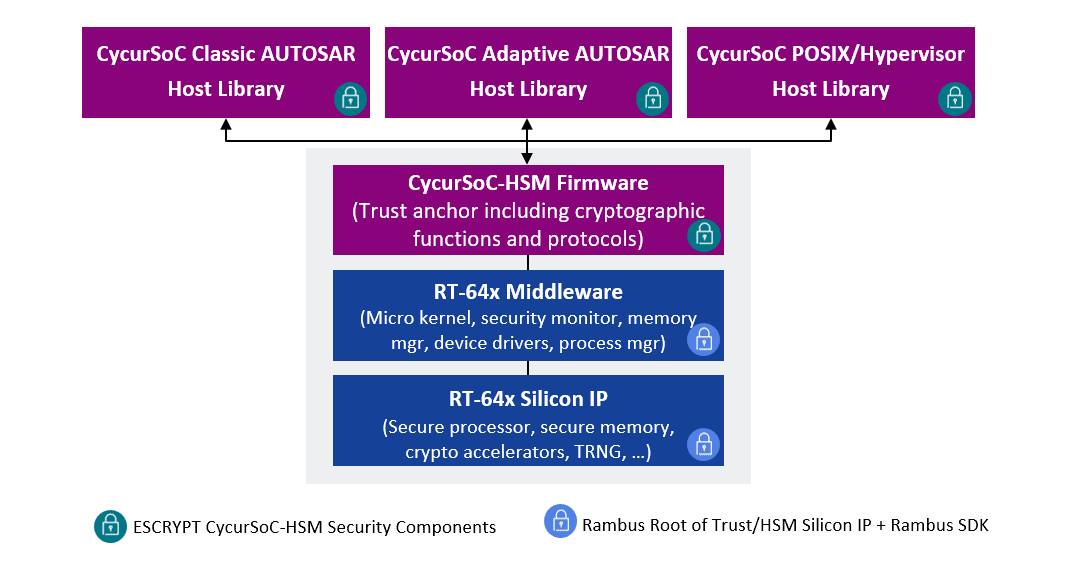Highlights
- Supports need for integrated software and hardware offerings providing faster time to market
- Reduces risk with pre-integrated, pre-validated, pre-certified full HSM stack solution
- Raises the bar for automotive safety and security for the software-defined vehicle
[Last updated: April 25, 2024] The automotive industry is undergoing an exciting transformation towards the software-defined vehicle (SDV) that will enable a new era of customer-centric mobility and create new business opportunities and revenue streams for automotive stakeholders. However, this transformation comes with its own set of challenges that demand revolutionary approaches to navigate the ever-increasing complexity, while at the same time meeting faster time to market (TTM) demands and regulatory safety and security compliance for market access.
One such approach is strategic collaborations within the automotive ecosystem, like the one ETAS and Rambus recently announced to co-develop and provide a bundled cybersecurity solution. We are excited to share more details about this unique, pre-integrated, and pre-validated solution that unites Rambus hardware and ETAS software expertise to create a secure enclave on next-generation automotive silicon designs.
Table of Contents:
Automotive System-on-Chip (SoC) Challenges
Automotive-grade SoCs have evolved significantly in the last decade from microcontroller-based chips to more advanced and complex microprocessor-based SoCs. This evolution is a response to the never-ending demands for greater computing to fulfill different use cases and enhance customer experiences. The progression in hardware architecture has enabled greatly increased functionality such as Advanced Driver-Assistance Systems (ADAS), automation, E/E vehicle architecture transformation, and much more, to realize the software-defined vehicle (SDV). This technological evolution at the SoC level is opening a new era in the automotive industry, but it also comes with challenges. One of the critical challenges is the diverse and heterogenous architecture of these SoCs with multiple computing islands for different applications. This diversity in the hardware architecture is making security implementations more complex and integration more time consuming for automotive OEMs and Tier 1 system engineering teams.

Hardware Security in the Automotive Industry
Over the last decade, the automotive industry has increasingly relied on Hardware Security Modules (HSM) as the trusted hardware platform for secure tamper-resistant cryptographic operations and key management. HSMs offer various security services and capabilities, including secure communication channels, data integrity protection, message authentication, secure boot processes, and system security policies.
HSMs securely execute authenticated user applications with security mechanisms like tamper detection and protection, secure storage and handling of keys and security assets, and resistance to side-channel attacks. Access to cryptographic accelerator modules, keys, memory ranges, I/O, and other resources is enforced by hardware. Critical operations like encryption, signing, authenticating, key generation, derivation, and storage are performed in hardware without external software access.

Originally, HSMs were offered as standalone secure element chips or HSM-embedded automotive microcontrollers connected to host system buses. However, the HSM landscape has evolved to meet modern automotive systems’ increased complexity, stricter security requirements, and performance demands. Today, HSMs are siloed hardware blocks (IP) instantiated in automotive SoC ICs. In some SoCs, there are multiple HSM IP blocks to fulfill a variety of security use cases and demands.
This new trend in HSMs reflects the growing importance of cybersecurity in highly connected vehicles, and at the same time, it supports the need for pre-integrated, pre-validated, pre-certified, scalable solutions to help OEMs meet safety and security compliance. Synthesizable automotive-grade HSM silicon IP has emerged as a critical strategy for efficient and effective SoC development.
As with any silicon IP design, the synthesizable automotive-grade HSM IP provides greater flexibility for customization to meet specific performance requirements for critical use cases. The technology-agnostic nature of the HSM silicon IP offers a cost-effective and scalable solution for securing multiple SoCs. Safety and security certified HSM IP enhances the overall reliability and quality of the SoC, minimizing the risk of design and cybersecurity flaws, while ensuring faster compliance at the chip level.
Integrated HSM Hardware and Software Stack – The Solution
To further support OEMs and SoC developers manage design, safety, security, and cost challenges, an integration of the HSM hardware and software stack is required. Specifically, synthesizable HSM hardware IP should come with pre-integrated, pre-validated embedded HSM software (SW). This would enable a technology-node agnostic, full hardware IP-SW stack ready to be integrated into any SoC allowing the security SW integration development to start 18-24 months earlier at the automotive Tier 1 or OEM level. It would also avoid costly and lengthy porting, integration, and validation efforts typically needed for the HSM SW integration with standalone HSM chips or dedicated embedded HSM-based microcontrollers.
Innovative iHSM Solution from ETAS and Rambus
ETAS and Rambus are now offering a new integrated hardware security module (iHSM) product family that combines the Rambus RT-64x Root of Trust IP with the ETAS embedded cybersecurity software solution ESCRYPT CycurSoC.


The ETAS-Rambus iHSM-64x solution ports ESCRYPT CycurSoC on the RISC-V-based Rambus RT-64x hardware architecture. Designed for automotive security use cases, the pre-integrated security solution is CMOS node agnostic, highly secure, and optimized for efficiency with minimal impact on available system resources. It supports open and standardized interfaces like SHE+, AUTOSAR Classic, Adaptive, POSIX and Hypervisor to Host applications. The full HSM stack (hardware silicon IP and software) is a pre-validated, drop-in solution critical to creating a security enclave on next-generation automotive silicon designs requiring ISO 26262 ASIL-B and ISO 21434 CSMS compliance.
Pre-integrated, pre-validated, pre-certified HSM SW on synthesizable automotive-grade HSM silicon IP is a welcome new trend and an emerging strategy in the HSM space for safer and more secure mobility. To find out more, check out the latest episode of the ETAS podcast in which guests Adiel Bahrouch from Rambus and Omar Alshabibi from ETAS will explore how ecosystem solutions can reduce implementation complexity and risk while accelerating time to market.



Leave a Reply